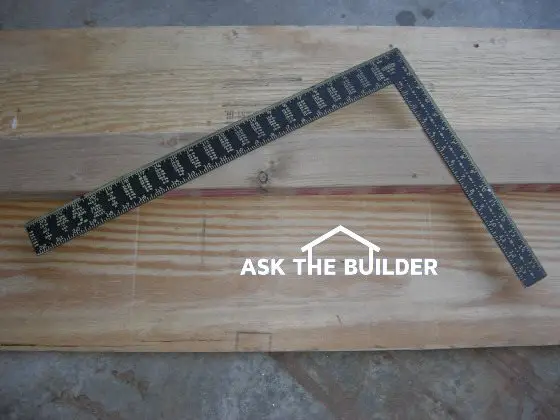Framing Square Tips

This simple metal tool can be used for countless home improvement and construction tasks. PHOTO CREDIT: Tim Carter
The Framing Square
DEAR TIM: My Dad passed away and I was cleaning his tool-room out. One of the strange tools I saved was a large L-shaped piece of flat metal that has ruler markings on it all over the place. I’ve been told this is an aluminum framing square, but don’t know if that’s accurate. What are framing squares used for? Is it practical to own one, as I never saw my Dad use this framing square. Mandy P., Topeka, KS
DEAR MANDY: I remember cleaning out my Dad’s tool room long after we had to send him back to Heaven. Some of the tools he used, and they weren’t great, I still have. I just can’t part with them. I hope you’ll come to cherish the tools you saved, including the multifaceted framing square you now possess. It’s a magical tool indeed.
I have four framing squares of my own. That’s more than I need, but they are split up in between two houses. When I was still actively building, I always had two of these tools with me on my truck, and a third one in my workshop.
Ask ten different carpenters what their favorite use of a framing square might be and they’ll probably each tell you something different. When I was still building every day, you would find me using my square to create the angled lines on large framing lumber that would then be transformed into roof rafters. I also used my square to create parallel lines, spaced 1.5 inches apart and on 16-inch centers, on long 2x4’s that would be the top and bottom plates for walls. A vertical wall stud would fill the gap between the closely spaced lines.
The versatility of the framing square comes from the fact that the two legs, the body and the tongue, are set at exactly 90 degrees from one another. The body of the square is often 2-inches wide and almost always 24-inches long. The tongue is 1.5 inches wide and typically 16-inches long. One of my Dad’s tools I now own is a miniature framing square that 1/3 the size of a standard one.
If you remember your grade school or high school geometry classes, a 90-degree angle is considered square. If you have a rectangle or a square, each corner is 90 degrees. This flat tool you now own allows you to check the intersection of two lines to see if they are square.
You can use a framing square for any number of tasks. It makes a great straightedge if you’re trying to cut a very straight line with a razor knife. You carefully hold the tool in place and slowly slide the razor along the edge of the tool.
I taped a video one day showing how you can use a framing square to make a perfectly square cut when using a circular saw. If you’ve ever tried to cut a wide 2x10 or 2x12 before, you know it can be tough to keep the saw blade on the pencil line. If you clamp a framing square to the lumber, you can produce a square cut by sliding the flat bottom plate of the saw against the edge of the square. Bingo, a square cut!
You can use them to check the inside corners of a room for square by placing the tool into the corner. If there is no gap between the wall surfaces and the outside edges of the square, the walls might be square to one another. I say might, because the tool can’t tell you what’s happening to the walls beyond where the tips of the square are. What’s more, drywall compound used to cover the taped corner joint almost always makes the corners not square.
One thing you better do before you use your square is to check it to make sure it is square. Yes, it’s possible the tool was of poor quality to begin with or it may have been abused. You need to use your high school geometry to check it. Just do what Pythagoras, the famous Greek mathematician, would do if he had it in his hands.
He would take an accurate measuring tape and carefully measure to see if the tongue was 16 inches long and see if the 12-inch mark on the outside edge of the body is actually 12 inches from the outside corner of the square. If these measurements were accurate, he would then take the tape and hold it diagonally from the tip of the tongue on the outside edge and extend it to the 12-inch mark on the outside edge along the body. If the diagonal measurement is exactly 20 inches, the tool is still square!
Framing squares are a must-have tool for home improvement and building. They’re not expensive, and they deliver accurate results their entire life if you treat them well. Perhaps the most common one is an aluminum framing square. I do have a steel square, but it can rust if the protective coating gets worn off.
There are tables and other numbers on high-quality squares that allow you to do a multitude of tasks with the square. The most helpful tables on the square will help you cut roof rafters to the correct length if you know the roof slope. Roof slope is commonly called out in so many inches of rise per foot of run. A low-slope roof may be called a 4 / 12 slope roof because for every 12 inches of horizontal run, the roof goes up in elevation 4 inches. Hang around a seasoned master carpenter for a day and it may all make sense to you!
Column 814
One Response to Framing Square Tips